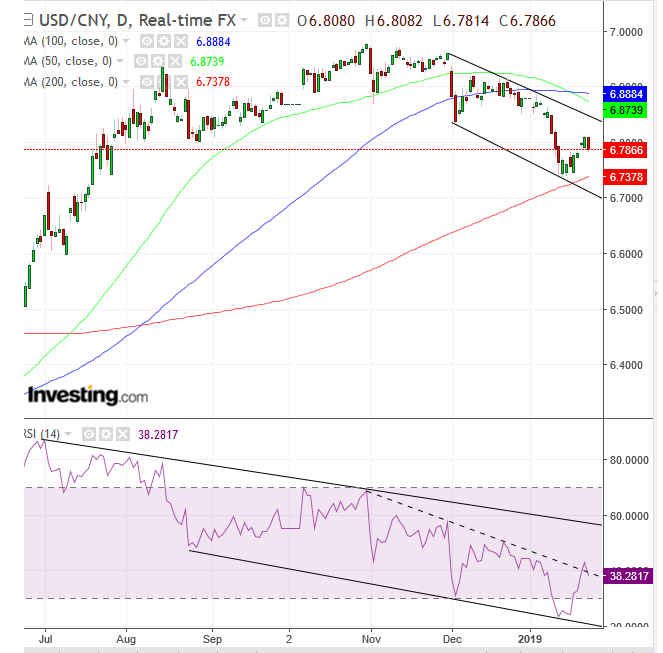While there are a multitude of market forces and outlooks at play, China seems to be at the focal point of them all: a trade war and a contracting Chinese economy, creating a knock-on effect on big tech and prompting warnings of lower profits. Given that four of the five biggest tech companies in the world—Apple (NASDAQ:AAPL), Amazon (NASDAQ:AMZN), Microsoft (NASDAQ:MSFT) and Facebook (NASDAQ:FB)—release earnings, and provide guidance this week, we can expect a lot of trading action.
Also, considering that a core point of contention between the world’s two largest economies is the charge that China manipulates its currency to gain unfair advantage in the global market, we're likely to see considerable volatility for the yuan at the same time.
The current market narrative presumes the yuan’s strengthening is due to increased demand amid a positive outlook for the Asian nation with a resolution of the trade dispute. It is possible, however, that China may be ensuring there is increased demand to ease negotiations amid a barrage of US charges. China's Vice-Premier Liu He will be in Washington January 30-31 for further trade talks, which are expected to include discussions about the country's currency policies.
The technicals indicate the continuing strong correlation with fundamentals. Prices peaked in November on news of the U.S. and Chinese Presidents' meeting in Argentina, then dropped, accelerating the rate of descent when talks began. The RSI provided observant traders with a heads-up for a reversal, when momentum dropped from late June to late October, against a rising price, which turned out to be the top.

The moving averages demonstrate that weakness is not random but occurs over multiple time frames. The 50 DMA crossed below the 100 DMA amid the quickened pace of the USDCNY selloff; today it fell below the 200 DMA, where it remains, even after a rebound.
We have been bearish on this pair for months, and we continue to be so—whether because a resolution would boost the CNY or because China will make sure it strengthens.
Trading Strategies
Conservative traders would wait for a fall to 6.7000, the bottom of the descending channel, to demonstrate that today’s rebound won't turn into a reversal, and that the 200 DMA was breached. Then, they’d wait for an upward correction, which would not scale above the January 22 peak of 6.8112. Then, they would wait for resistance confirmation, with at least one long, red candle following a green or small candle of either color.
Moderate traders would do well to wait for a retest of the previous peak before shorting, as described above.
Aggressive traders may enter a contrarian, long position, if the current hammer pattern remains till closing. Also, they should take into consideration that prices may test the support of the hammer, as low as 6.7221, before turning around. Should this be the case they should manage their trade accordingly.
Trade Sample
- Entry: 6.7300
- Stop-Loss 6.7200
- Risk: 100 pips
- Target: 6.7600
- Reward: 300 pips
- Risk-Reward Ratio: 1:3
